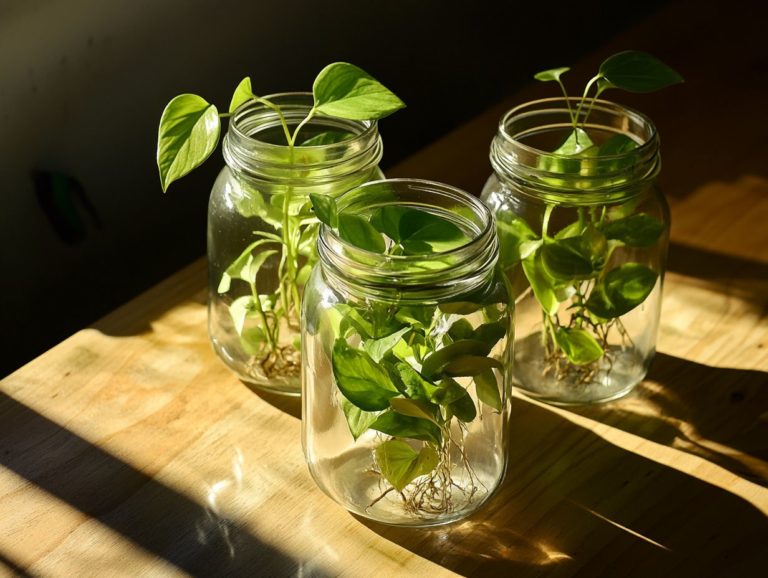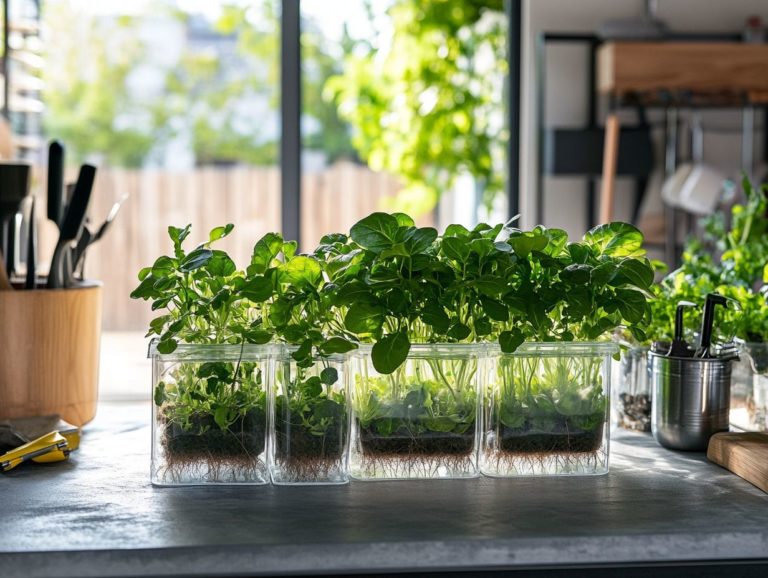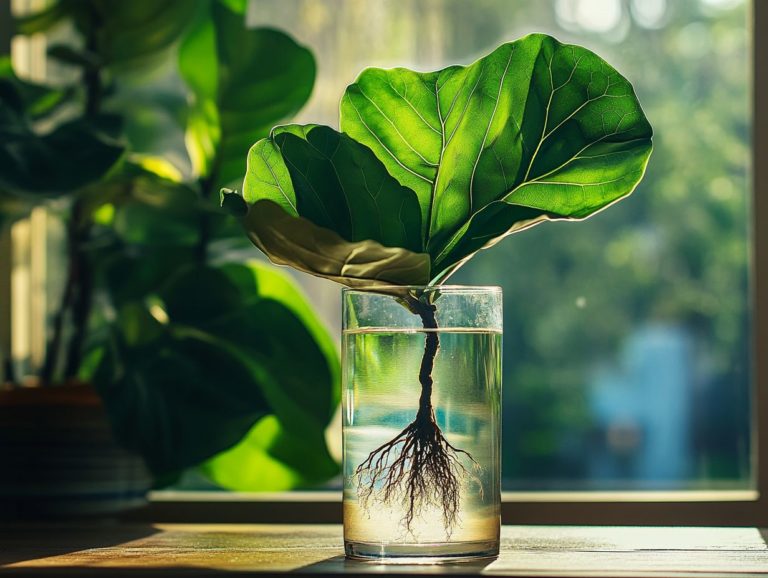Understanding Plant Propagation Hormones
Plant propagation hormones are crucial in the growth and development of plants, serving as natural signals that regulate a myriad of processes.
These hormones are indispensable for gardeners and horticulturists, stimulating root growth, promoting flowering, and controlling overall plant development through effective gardening tips.
This article will guide you through the various types of plant propagation hormones such as auxins, cytokinins, and gibberellins and provide insights on how to utilize them effectively to enhance your plant propagation success.
Regardless of whether you re just starting out or have years of experience, grasping the intricacies of these hormones can significantly elevate your plant care tips.
Contents
- Key Takeaways:
- Types of Plant Propagation Hormones
- Uses of Plant Propagation Hormones
- How to Use Plant Propagation Hormones
- Application Methods and Dosages
- Frequently Asked Questions
- What are plant propagation hormones?
- Why are plant propagation hormones important?
- What are the different types of plant propagation hormones?
- How are plant propagation hormones used in gardening and farming?
- Are plant propagation hormones safe for human consumption?
- Can plant propagation hormones be harmful to the environment?
- Frequently Asked Questions
Key Takeaways:
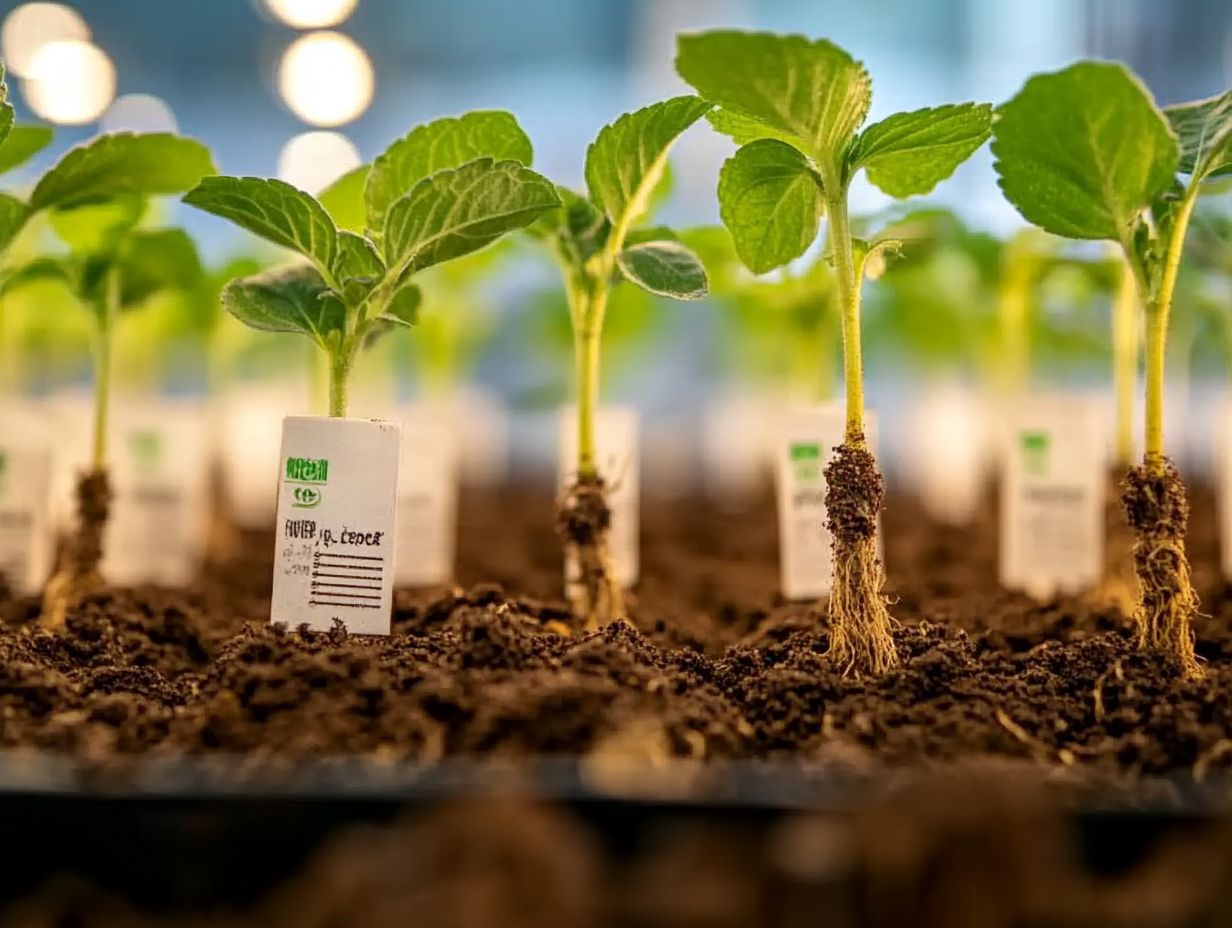
- Plant hormones are natural substances that help regulate plant growth.
- Main types include auxins, cytokinins, gibberellins, abscisic acid, and ethylene.
- These hormones can stimulate root growth, promote flowering, and control overall plant health.
What are Plant Propagation Hormones?
Plant propagation hormones, particularly rooting hormones, are essential for successfully propagating a variety of plants, including houseplants, succulents, and other cuttings.
These natural or synthetic compounds play a significant role in regulating plant growth by influencing cell division (the process of growing new cells) and elongation (the stretching of these cells). This enables the development of robust new root systems.
For example, auxins, a primary type of rooting hormone, stimulate root formation right at the cutting site. You can easily find popular auxins that can help you boost root development in your garden. Synthetic variants often include additional ingredients that enhance their effectiveness.
Using these hormones boosts rooting success rates. They also speed up recovery and growth in your cuttings, enhancing the effectiveness of your rooting hormone application.
By incorporating rooting hormones into your propagation routine, you set the stage for stronger, more resilient plants, paving the way for flourishing gardens and improved plant health, whether indoors or outdoors.
Types of Plant Propagation Hormones
Understanding the different types of plant propagation hormones is crucial for your gardening and plant care endeavors. These hormones play a vital role in shaping plant growth regulation and development.
The primary categories auxins, cytokinins, gibberellins, abscisic acid, and ethylene each have distinct functions that contribute to the rooting process and the overall health of your plants.
Embracing this knowledge gives you the power to nurture your garden more effectively.
Auxins
Auxins are a fascinating group of plant hormones that play a crucial role in root formation and the regulation of overall plant growth. They are essential for anyone serious about effective rooting hormone application and successful propagation.
Common rooting hormones are frequently used in gardening to boost root development in plant cuttings, often referred to as cuttings that root.
These hormones work by stimulating the cells in your cuttings to elongate and divide, which is essential for establishing new roots that are vital for water and nutrient absorption.
For optimal effectiveness, consider applying them to the cut end of a stem before planting. This simple step can significantly enhance your chances of successful rooting and new plant growth.
By understanding how auxins influence hormonal pathways and root initiation, you can use these substances strategically, whether you re propagating houseplants or tackling larger landscape specimens using the stem cutting method.
Ultimately, with the right application of auxins, you re not just speeding up root development you re also nurturing healthier, more robust plants that will thrive in your garden.
Cytokinins
Cytokinins are vital plant hormones that promote cell division and influence growth. They are essential for enhancing the overall health of your plants during propagation. These hormones work together with auxins to ensure balanced growth and effective root development in your cuttings.
In your plant care journey, cytokinins play a crucial role by stimulating leaf expansion and helping your plants withstand stress. This benefit is particularly valuable during the propagation phase. When you’re propagating, leverage cytokinins to boost root formation and enhance the vitality of your young plants. This facilitates a stronger establishment in their new environment.
This harmonious blend of growth factors results in healthier cuttings that are better equipped to survive the transplanting process. Ultimately, by applying cytokinins, you not only accelerate growth rates but also fortify the resilience of your propagated plants. This ensures they thrive as they adapt to their surroundings through safe rooting hormone practices!
Gibberellins
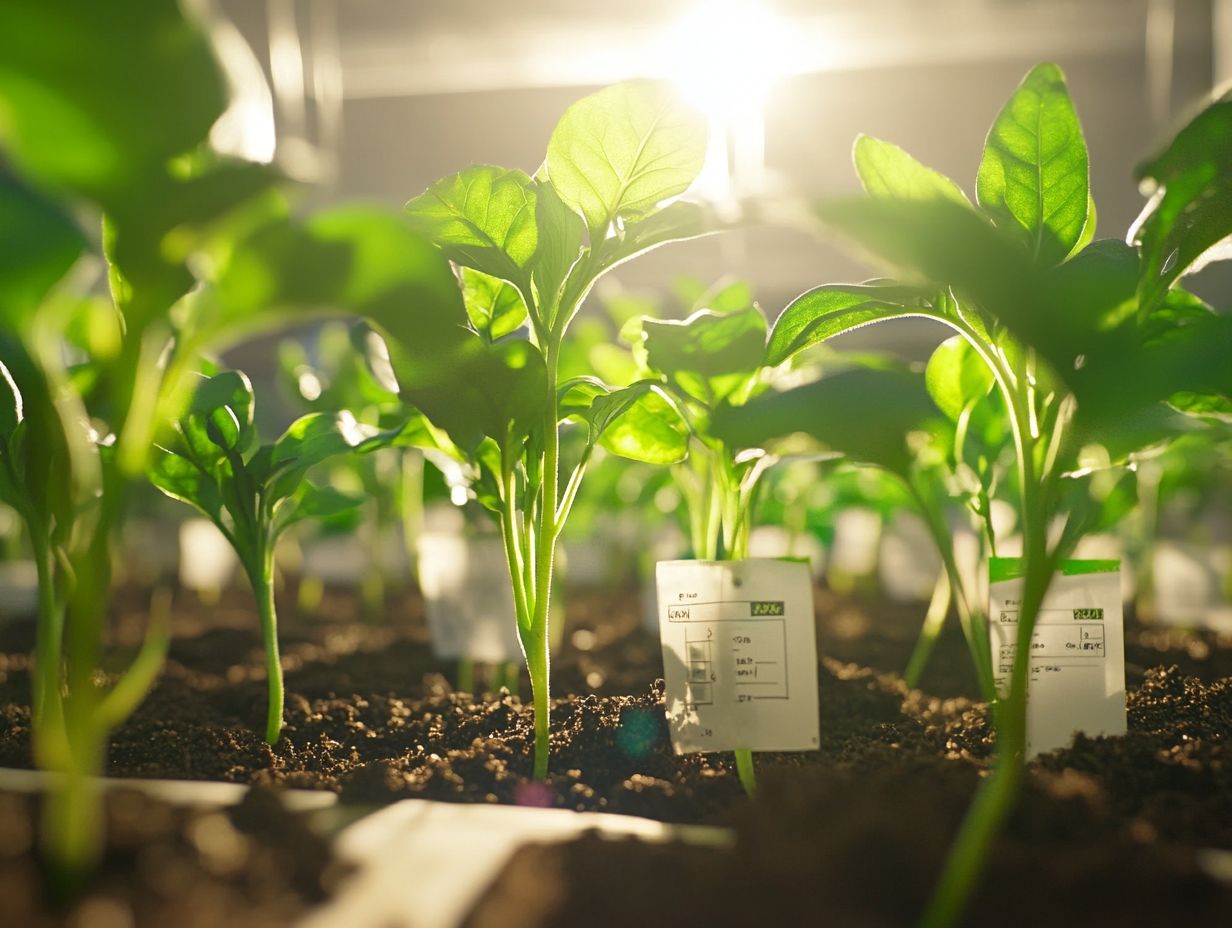
Gibberellins are essential growth hormones that play a pivotal role in plant development. They are especially important in processes like seed germination and stem elongation. Recognizing their importance can help you optimize plant growth during propagation, leading to successful outcomes!
These hormones promote cellular elongation and division, crucial for growing strong stems and leaves. They effectively break seed dormancy, allowing seeds to sprout under ideal conditions and enhancing overall plant vitality. You ll find that gibberellins significantly reduce the time it takes for seeds to germinate, accelerating crop production.
In various agricultural practices, applying gibberellins can lead to increased yields and improved quality of fruits and flowers. This is especially true when combined with effective gardening supplies. Embracing gibberellins in your growth strategy could transform your results!
Abscisic Acid
Abscisic acid is an essential plant hormone that significantly impacts stress responses and overall plant care. It influences a range of physiological processes. Understanding this hormone is crucial for grasping plant behavior during propagation, particularly regarding root development and resilience.
When facing environmental stressors like drought, salinity, or extreme temperatures, abscisic acid enables plants to adapt. It promotes stomatal closure (which means closing leaf pores) to minimize water loss and facilitates root growth. This is critical for enhancing water and nutrient uptake. As you propagate plants, fostering robust root development is key to ensuring higher survival rates for your new green companions!
By bolstering the plant’s ability to manage stress, this hormone plays a vital role in the overall health and success of your gardening efforts. It is an essential element of effective plant care!
Ethylene
Ethylene is a remarkable plant hormone that plays a pivotal role in the ripening process of fruits. It also influences plant growth and development. By understanding the effects of ethylene, you can gain valuable insights into effective plant care and successful propagation strategies.
This gaseous hormone is essential for various physiological processes, including seed germination, flower senescence, and leaf abscission. It directly impacts plant growth and development by facilitating the ripening of fruits like bananas and tomatoes. This ensures they develop optimal flavors and textures, ultimately impacting consumer preferences and marketability!
Ethylene significantly influences overall plant health. It helps regulate responses to stress, allowing plants to adapt to challenging conditions, thereby enhancing their success in propagation efforts. Mastering the management of ethylene production can enhance your gardening success and cultivate healthier, more resilient plants!
Uses of Plant Propagation Hormones
Plant propagation hormones offer a range of essential benefits in gardening and horticulture, playing a key role in stimulating root growth, encouraging flowering, and regulating the growth and development of various plant cuttings, especially when utilizing rooting hormone benefits.
Understanding these applications can elevate your plant care practices, leading to truly remarkable results in your gardening endeavors.
Stimulating Root Growth
One of the primary uses of plant propagation hormones is to stimulate root growth in your plant cuttings; the application of rooting hormone is a crucial step in successful propagation. By utilizing effective gardening tips, you can further enhance root development and ensure that your cuttings thrive.
You should choose the right type based on the specific needs of your plants, including the use of rooting hormone powder or gel. For example, softwood cuttings often respond remarkably well to quick-dissolving powders that can be mixed with water, while hardwood cuttings may benefit more from a paste-like consistency for optimal adhesion. Before applying the hormone, trimming the cutting at a 45-degree angle can increase the surface area, allowing for better absorption.
You should maintain humid conditions and employ a misting system to significantly aid in the establishment of roots, which is crucial for effective root cuttings.
Promoting Flowering

Plant propagation hormones play a key role in encouraging flowering across a variety of plants, resulting in a garden that s not just alive, but thriving. By harnessing specific plant hormones during propagation, you can elevate your plant care game, help you learn effective plant propagation, and achieve stunning flowering outcomes.
Hormones like auxins, gibberellins, and cytokinins influence essential plant processes. Auxins encourage cell elongation, which translates to stronger, taller blooms. Meanwhile, gibberellins stimulate flowering by activating specific genes that initiate flower development. Cytokinins, on the other hand, promote cell division, giving those flowers an extra boost.
To maximize these hormones, timing and application method are key. Think about foliar sprays or mixing them into the soil, always keeping the right dosage in mind for maximum effectiveness.
Understanding your plant’s unique needs will set you on the path to successful gardening.
Controlling Growth and Development
Controlling the growth and development of plants is a crucial application of plant propagation hormones, as these substances regulate various physiological processes essential for plant health. By employing the right rooting hormone, you can enhance growth regulation and elevate your overall plant care.
Hormones like auxins, gibberellins, and cytokinins significantly influence root formation, shoot elongation, and overall plant vigor. When you skillfully manipulate these hormones, you can induce earlier flowering and fruiting, ultimately leading to higher yields and a more robust plant structure.
Understanding the delicate balance of these substances is vital to avoid issues like stunted growth or excessive leaf drop, highlighting the importance of comprehension of rooting hormone benefits.
With careful application, you not only foster healthier plants but also ensure a well-timed harvest, enhancing your overall plant growth.
How to Use Plant Propagation Hormones
Understanding how to utilize plant propagation hormones effectively is crucial for you as a gardener aiming to enhance your plant propagation success. This entails grasping the different application methods, determining the appropriate dosages, and following essential rooting hormone instructions to maximize effectiveness.
Choose the right type based on your plants’ needs now!
Start using these tips today to see amazing results in your garden!
Application Methods and Dosages
Application methods and dosages are crucial elements in the effective use of rooting hormones for your plant cuttings, directly influencing the success of your propagation efforts, especially when you use the right rooting hormone. Using the right techniques and measurements can improve your plant care and growth outcomes.
For example, when using powdered rooting hormones, a gentle dusting on the cut end of a stem cutting tends to work wonders. Conversely, liquid rooting hormones can be diluted generally at a ratio of one part hormone to ten parts water perfect for soaking cuttings before planting.
Softwood cuttings often require a lighter application, while hardwood counterparts thrive with appropriate soil for cuttings, which may require a more concentrated dosage. Maintaining high humidity levels is crucial for rooting and significantly aids in root development. Ensuring proper drainage is also essential and can dramatically enhance your rooting success rates.
Remember, each plant type has unique needs. Researching specific requirements helps ensure successful propagation and effective plant care.
Frequently Asked Questions
What are plant propagation hormones?
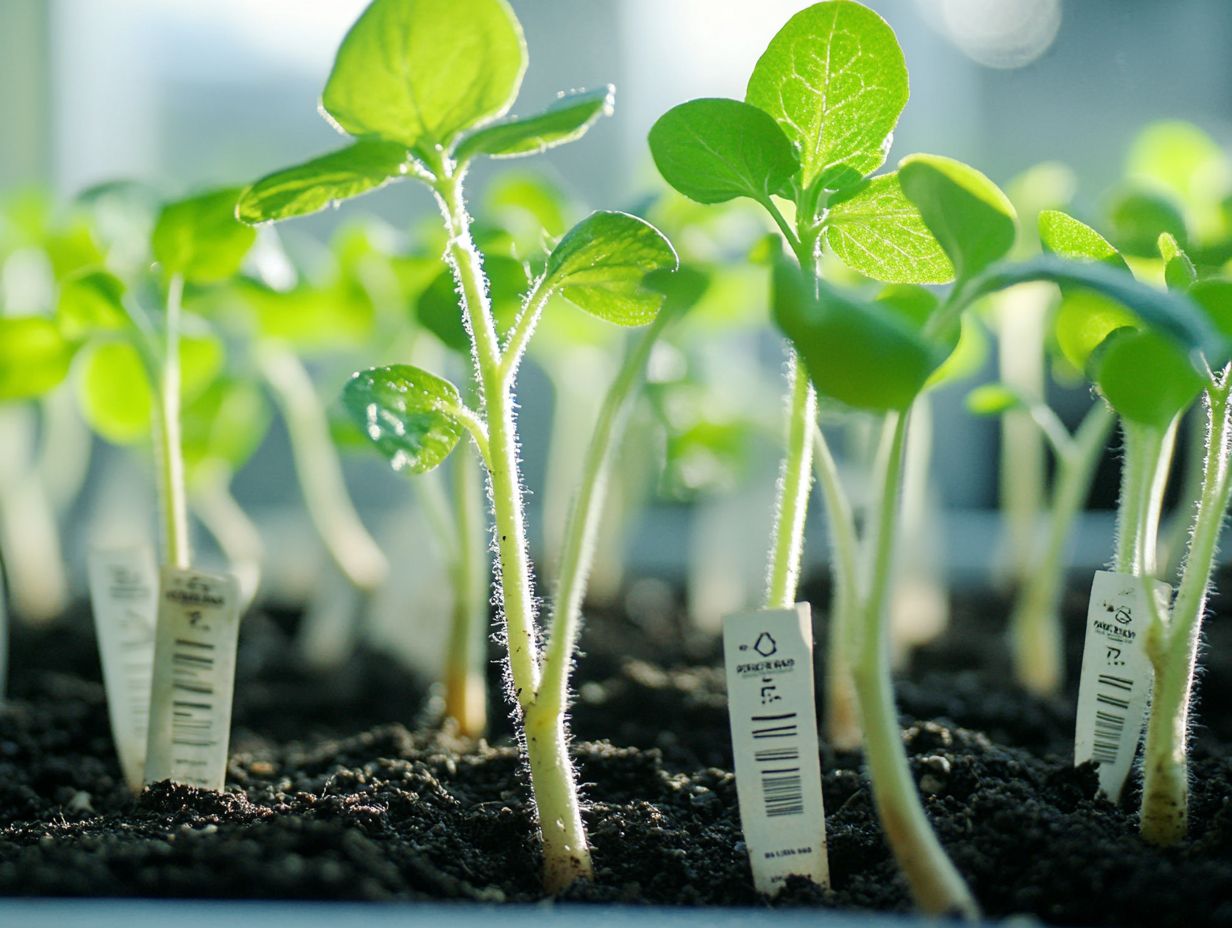
Plant propagation hormones are hormones that help plants grow and reproduce. They regulate various processes, such as root formation and cell division, which are important in horticulture practices, such as root growth, cell division, and flowering.
Why are plant propagation hormones important?
Plant propagation hormones are essential for your garden’s success! They help with root development, shoot growth, and overall plant health, making them key for effective propagation methods.
What are the different types of plant propagation hormones?
The main types of plant propagation hormones, including auxins in plants, are auxins, cytokinins, gibberellins, abscisic acid, and ethylene. Each type has a specific function in plant growth and development.
How are plant propagation hormones used in gardening and farming?
In gardening and farming, plant propagation hormones are used to stimulate root growth, promote flowering, and increase fruit production. They can also be used to propagate new plants from cuttings or seeds.
Are plant propagation hormones safe for human consumption?
Yes, plant propagation hormones are safe for human consumption as they occur naturally in plants and are found in small amounts in fruits and vegetables. However, synthetic rooting hormone should be used with caution and according to the instructions on the label to ensure safety.
Can plant propagation hormones be harmful to the environment?
When used improperly, synthetic plant propagation hormones can be harmful to the environment and affect gardening tools and practices. They can disrupt the natural balance of hormones in plants and impact the growth and development of other organisms.

